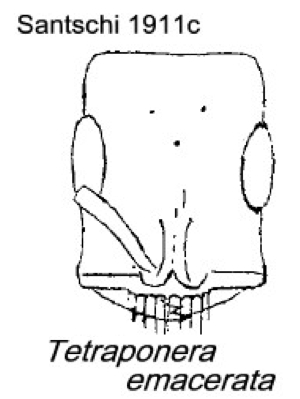Tetraponera emacerata (Santschi)
  Type location Kenya (Sima
mocquerysi stirps. emacerata nov., Santschi, 1911c: 352,
illustrated, worker; Santschi, 1914b: 70, queen; raised to species
Santschi, 1920b: 9, but cited as subspecies again by Santschi, 1933b:
100?; in Tetraponera, Wheeler, 1922: 107; species in Bernard,
1952: 221) Type location Kenya (Sima
mocquerysi stirps. emacerata nov., Santschi, 1911c: 352,
illustrated, worker; Santschi, 1914b: 70, queen; raised to species
Santschi, 1920b: 9, but cited as subspecies again by Santschi, 1933b:
100?; in Tetraponera, Wheeler, 1922: 107; species in Bernard,
1952: 221)
subspecies
oberbecki (Sima
Oberbecki n. sp., Forel,
1911f: 275; queen described by Forel, 1916: 403; worker & queen)
from Zaïre, collected at Leopoldville by Kohl
odiosa (Sima Prelli For. v. odiosa
n. var., Forel, 1916:
403, worker) from Zaïre, collected by Kohl
worker and queen
described (see Bolton, 1995)  . .
|
 WORKER
- TL 5.0-6.0 mm; with a narrow head (after Wheeler,
1922). WORKER
- TL 5.0-6.0 mm; with a narrow head (after Wheeler,
1922).
Wheeler (1922) listed a number of findings (as a ssp of mocquerysi)
from Kenya, Uganda and from Zaïre.
Forel (1911f) described Sima oberbecki, as a
"new
species", comparing it to Sima prelli [Tetraponera prelli] Forel (type
location
Tanzania), as follows -
TL 6 mm; head longer, about a quarter longer than wide, parallel sided;
posterior border more strongly impressed (prelli, mocquerysi
and anthracina being enlarged in the posterior one-third and
with convex sides). Only two ocelli. Eyes occupying two-fifths of the
sides of the head, slightly flatter and more elongated. Funiculus
segments 3-10 as long as wide, segment 2 longer than wide. Pronotum
similar in form, straight sided, but longer than wide. Mesonotum a
straight half-moon, but the metanotal groove strongly impressed; More
anteriorly, there is a faint transverse line on the metanotum. Petiole
with distinct pedicel, about one-third overall node length; otherwise
as in prelli but higher and wider anteriorly; postpetiole
similar to prelli but with a larger attachment to the gaster.
Colour brown black; mandibles, anterior of head, antennae, frontal
lobes, tarsi and joints testaceous.
Specimens from Zaïre, Congo da Lemba, by Mayné.
Forel (1916) noted Kohl found an oberbecki
female in
the same plant as T. aethiops at Leopoldville; odiosa
which he again separated as a variety of prelli, but with an
entirely black body and rust-brown appendages, was taken with T.
mocquerysi on Barteria fistulosa.
Bernard (1952) noted that, in Guinea, 4 workers
were
found from N'Zo, Nion and Camp IV (1000 m); the form being widely
spread in central and eastern Africa.
Without sight of the emacerata
type specimen, it is difficult to be sure but the two Forel forms
appear identical to each other and very similar, although darker, to prelli. The head shape of
both differs from the Santschi illustration.
|